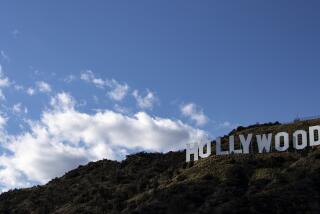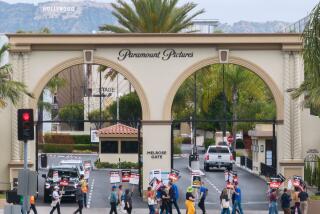MONEY : A Piece of the Action
As a child, Peter Fonda was paid $2.50 an hour for helping his father learn dialogue.
Steve McQueen’s daily pay as an extra in the 1960 film “Somebody Up There Likes Me” was $19. In 1980, his fee for his last film, “The Hunter,” was $3 million plus a percentage of the profits.
In 1937, during a Los Angeles benefit for Ohio River flood victims, Harold Lloyd outbid Cary Grant for a kiss from Ginger Rogers. Lloyd paid $400.
Amount eventually paid to Marlon Brando for 12 days’ work on “Superman” in 1978: $18.5 million.
Approximate current cost of installing a star on the sidewalk in the Hollywood Walk of Fame: $3,500.
Dorothy’s ruby slippers from “The Wizard of Oz,” auctioned by MGM, sold for $15,000. The Cowardly Lion’s costume sold for $2,400.
The Musso & Frank Grill, Hollywood’s oldest restaurant, opened in 1919. Bouillabaisse, a specialty, sold in the 1920s for $1.95. Today’s price: $14.75.
Cost of constructing the original Hollywood sign in 1922: $21,000. Cost of building a new one in 1978: $250,000.
Cost of installing klieg lights along the route of the Hollywood Christmas Parade each year: $5,000.
Projected budget for the 35-year redevelopment project approved in May, 1986, for 110 acres in downtown Hollywood: $1 billion.
In 1937, Louis B. Mayer, reportedly the highest-paid man in the United States, earned $1,296,000.
Annual payroll of the movie industry in 1920: $25 million. In 1984: $3,936,000,000.
During World War II, stars auctioned personal effects to raise money for War Bonds. A lock of Veronica Lake’s hair brought $185,000.
Western Costume Co., now on Melrose Avenue, was established in 1912. Its collection of 1 million costumes, the largest in the world, is valued at $50 million. In the early 1920s, a cowboy outfit rented for $5. Today the price is $100.
In 1984, CBS / Fox Video paid the highest fee ever for video rights to a movie when it bought rights to “Star Wars” for $15 million.
In 1943, Americans spent more than 25% of their recreation dollar on movies. By 1984, the figure had dropped to 2.5%, amounting to an annual expenditure of $4.1 billion.
With figures adjusted for inflation, “Gone With the Wind” remains the highest-grossing film of all time. Its revenues from North American rentals alone total, in current dollars: $321,603,000.
During the making of “Casablanca” in 1942, Humphrey Bogart’s wife, Mayo Methot, threatened to kill him if he left her. Agents Sam Jaffe and Mary Baker, who negotiated Bogart’s contract with Warner Bros., took out an insurance policy on his life for $100,000.
The largest sum ever paid for the movie rights to a novel--”The Exorcist,” by William Peter Blatty--was more than $3.5 million.
The biggest money-losers from 1981 through 1985 were “Heaven’s Gate,” which lost $55.5 million; “Inchon,” which lost $44.1 million; “Cotton Club,” loser of $38.1 million; “One From the Heart,” which lost more than $25 million.
More to Read
Inside the business of entertainment
The Wide Shot brings you news, analysis and insights on everything from streaming wars to production — and what it all means for the future.
You may occasionally receive promotional content from the Los Angeles Times.










